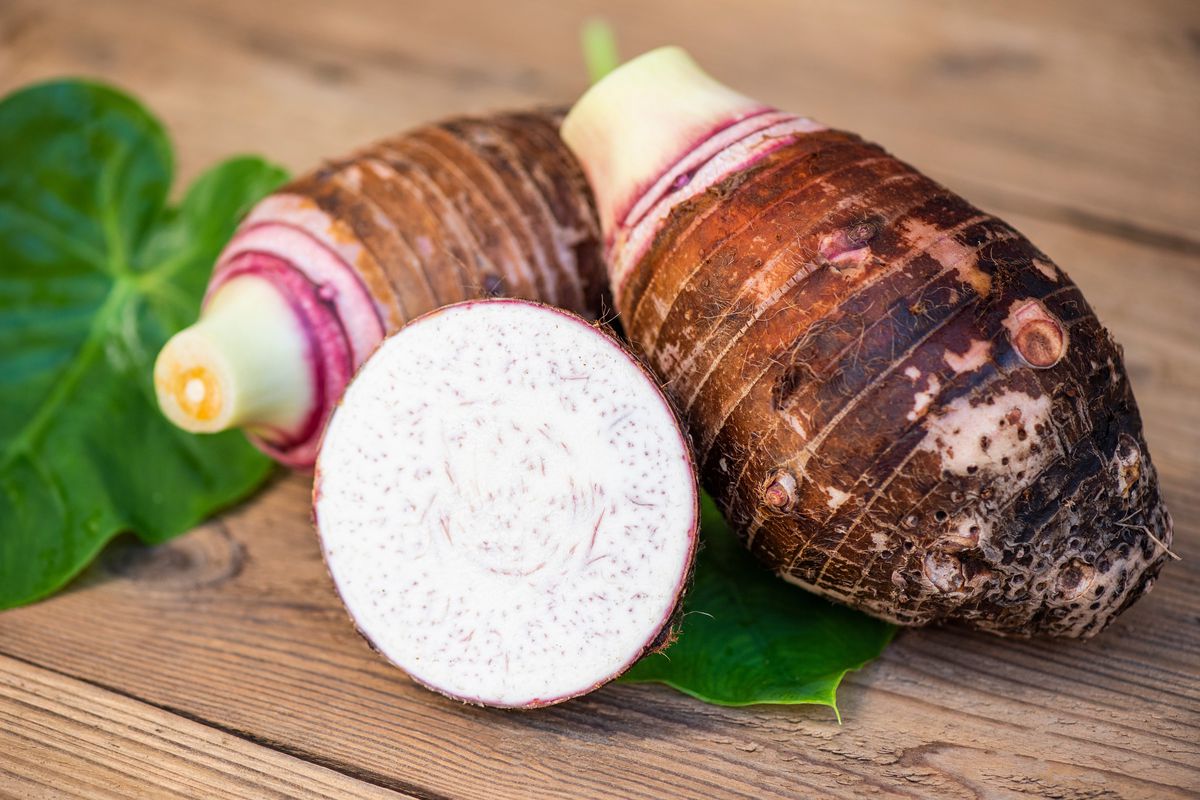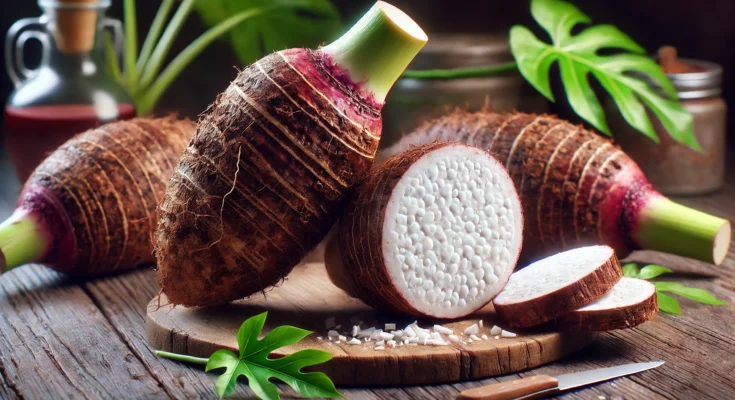Taro root (scientifically known as Colocasia esculenta) is a starchy tuber that has been a staple in many parts of the world, particularly in tropical and subtropical regions. This versatile root vegetable is not only celebrated for its nutritional value but also for its wide array of culinary uses and potential sustainability benefits. In this article, we’ll explore the health benefits of taro root, its diverse uses in cooking, and how it contributes to a sustainable food system.
What is Taro Root?
Taro root is a tuber that comes from the Colocasia plant, a member of the Araceae family. Native to Southeast Asia and the Pacific Islands, taro has spread globally, especially in tropical climates where it thrives. The root is typically large, with a rough, brownish exterior, and its flesh can range from white to purple or pink, depending on the variety.
Often mistaken for yam or sweet potato, taro has its own distinct flavor and texture. The taste is slightly nutty and earthy, and the texture is smooth when cooked, making it a popular ingredient in savory and sweet dishes.
Health Benefits of Taro Root
Taro root is more than just a versatile food item; it’s packed with essential nutrients and offers various health benefits. Here’s why you might consider adding it to your diet:

1. Rich in Nutrients
Taro root is an excellent source of dietary fiber, vitamins, and minerals. It is particularly rich in:
- Vitamin E: Acts as a potent antioxidant, promoting skin health and protecting against cellular damage.
- Vitamin C: Boosts the immune system, improves skin health, and helps in wound healing.
- Potassium: Aids in maintaining proper heart and muscle function.
- Magnesium: Supports muscle and nerve function and contributes to healthy bones.
2. High in Dietary Fiber
Taro root is an excellent source of dietary fiber, which is essential for digestive health. Consuming fiber-rich foods like taro can help regulate bowel movements, prevent constipation, and promote a healthy gut microbiome. The high fiber content also helps in managing cholesterol levels, which can reduce the risk of heart disease.
3. Good for Blood Sugar Regulation
Despite its starchy nature, taro has a relatively low glycemic index, meaning it has a slower impact on blood sugar levels compared to other high-carb foods like white potatoes. This makes it a good option for people managing diabetes or those looking to stabilize their blood sugar levels.
4. Supports Heart Health
Thanks to its potassium content, taro root can help in regulating blood pressure, reducing the risk of stroke and heart disease. Potassium helps balance the effects of sodium in the body, promoting better cardiovascular health.
5. Promotes Weight Loss
Taro root is low in calories and fat while being high in fiber, making it an excellent choice for those looking to manage their weight. The fiber in taro helps you feel fuller longer, reducing overeating.
6. Gluten-Free and Allergy-Friendly
Taro root is naturally gluten-free, which makes it a great alternative to wheat-based products for individuals with gluten intolerance or celiac disease. It’s also a great substitute for other allergy-prone foods, like potatoes or corn.
Culinary Uses of Taro Root
Taro root’s mild flavor and starchy texture make it a versatile ingredient in a variety of dishes, from savory to sweet. Here are some of the most popular culinary uses for taro:
:max_bytes(150000):strip_icc()/Akra-Crispy-Taro-Root-Fritters-with-Caviar-and-Remoulade-FT-RECIPE0823-18a99d8fe61b457eaa6da375eceb690a.jpg)
1. Savory Dishes
Taro can be boiled, steamed, baked, or fried, and it is used in many savory dishes, often as a substitute for potatoes or other root vegetables. Some common applications include:
- Taro Chips: Thinly sliced and deep-fried, taro chips are a crispy, flavorful snack.
- Taro Stir-Fries: Taro can be diced and stir-fried with vegetables, meat, or tofu, adding an earthy flavor and texture.
- Taro Soup: In many Asian cuisines, taro root is used in soups or stews, where it’s often paired with pork, beef, or fish.
- Taro Dumplings: Taro can be mashed and used as a filling in dumplings or spring rolls.
2. Sweet Dishes
Taro’s natural sweetness makes it ideal for desserts and sweets. Some traditional dishes include:
- Taro Coconut Dessert: A popular dessert in many Pacific Islands and Southeast Asia, where mashed taro is mixed with coconut milk and sugar.
- Taro Ice Cream: A beloved dessert in Hawaii and other parts of the world, where the root is pureed and used to create a creamy, flavorful ice cream.
- Taro Cake: In some cultures, taro is used to make moist cakes that combine the flavor of the root with a touch of sweetness.
3. Taro Flour
Taro root can be dried and ground into a flour, which is gluten-free and can be used in a variety of recipes. Taro flour is commonly used in baking and as a thickener for soups and sauces.
4. Taro as a Substitute for Potatoes
Because of its similar texture and starch content, taro is often used as a substitute for potatoes in many dishes, especially in countries where potatoes are not as widely available.
Sustainability of Taro Root
As the global food system faces challenges such as climate change, soil degradation, and the need for sustainable farming practices, taro root stands out as a potentially sustainable crop. Here’s why:

1. Resilient to Climate Change
Taro is particularly resilient to changing climate conditions, especially in tropical and subtropical areas. It grows well in regions with consistent rainfall and can even be cultivated in waterlogged conditions, making it a viable crop in areas that experience floods or irregular rainfall.
2. Low Environmental Impact
Unlike many other staple crops, taro requires less intensive farming practices, such as heavy irrigation or chemical fertilizers. It’s relatively low-maintenance and can be grown in various types of soil, including poor and marshy soils. This reduces the environmental impact compared to more resource-intensive crops like rice or maize.
3. Biodiversity and Soil Health
Taro is often cultivated in traditional agroforestry systems, which help maintain biodiversity and improve soil health. The plant’s large, broad leaves provide shade to the soil and prevent erosion, which benefits the overall ecosystem.
4. Food Security
As a crop that is relatively easy to grow and harvest in tropical climates, taro has the potential to contribute to food security in developing regions. Its resilience to pests and diseases and ability to thrive in challenging environmental conditions make it an important crop for rural communities facing food insecurity.



